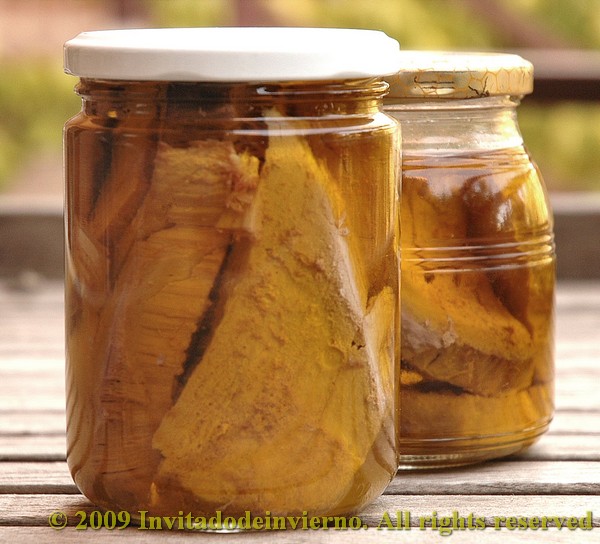
Canned tuna... I love the word... In Spain everybody likes tuna in oil or escabeche... in a salad, in stuffed eggs, in a pincho, oozing juices on the bread... mmm, I get carried away. All peculiar people in the world who don't like canned tuna, please stop reading this post, because it deals with how to preserve tuna fish. The concept and recipe comes from the blog Milcolores, although I made a mix with some recommendations from the blog Mercado Calabajío. I love these mixes... first you read 12 recipes about the same dish, then you do the average, you trim here, you add there, add a pinch of salt and check what comes out. Some times it turns out like Frankenstein, but some others the result is a real success, like in this case.
Ah... tuna fish. I'm bound to tuna fish by unbreakable bonds. I still recall a certain tuna fish festival we attended at Burela, Galicia, a few years ago. For a ridiculous price you could get a very elegant plastic plate with tuna empanada, two or three chunks of Galician bread and two or three chunks the size of my fist of tuna fish from Burela in escabeche... and a glass of Valdepeñas wine. The tuna fish was so sturdy that you could feel it soaking your vital juices, but in spite of that the empanada... the sunset... the atmosphere... the wine oozing out the corner of my mouth ... I will never forget that tuna fish... I can cry when I recall that tuna... I love you, tuna.

If you want to know about the different species of tuna, check this link. What I used for my tuna fish pie was northern blue fin tuna, and also for this recipe.
Now to the point, here's what I did:
- Here in Spain tuna fish is present in the market mainly in the Summer and it can be specially cheap at the end of it; buy a fair amount of tuna whenever you find it at a good price. Ask for the fish to be cut in rounds or on any way that let you fit it comfortably into a large pan. I bought 1,5 kg in rounds of 1 inch thick approx.
- Lay an awful lot of bay leaves on the bottom of the pan. I used an enameled Le Creuset pan.
- Lay the chunks of tuna fish on top of the bay and cover with water. It is important to measure the amount of water added, in order to calculate the salt to be added. The recommended amount is 85-95 g salt per liter of water. I used this ratio and I was satisfied with the result, although saltiness is a very personal thing.
- Cover the fish with another lot of bay leaves. Don't restrain yourself, the bay flavour is not strong in the final result, in spite of adding so many leaves.
- Boil the fish for 20-30 minutes, depending on the size of the pieces. Then put off the heat and let it cool.
- When the fish is cool to the touch, take it off the pan, drain it and eliminate skin and bones, in case you have boiled it whole.
- In the meantime you should have sterilized the glass jars you've chosen for the preserving, boiling the jars and lids in water for half an hour. Just drain them on a clean towel, in an upside down position, don't dry them in any way.
- In some blogs there's a recommendation for letting the tuna fish harden in the fridge overnight, wrapped in aluminum foil. I was impatient and I didn't follow this instruction. The result was very good anyway, so I don't deem this step really necessary. Then put the tuna fish pieces on a cutting board and try to cut rectangular pieces that can fit into the jars. The pieces must fit tightly so that you don't need to use a lot of olive oil.
- Once all the tuna pieces are acommodated, fill the jars with olive oil. Some people use sunflower oil, but I think no other oil gives the same flavour.
- Cover tightly with the lids and sterilize again the filled the jars in a pan with boiling water, on bain marie, for half an hour. Use the same water you used for the previous sterilization (recycling!), keep the water level just below the lids. Sterilization can also be done in a pressure cooker, at a higher temperature, but I haven't tried this method.
- Let the jars cool and keep in the fridge, just in case. It shouldn't be necessary if the sterilization has been correctly done, but in my case some jars oozed a little bit of oil when I took them out of the pan, which led me to suspect that maybe they were not tightly sealed. And I prefer to be on the safe side.
And now you're ready to enjoy a homemade oil-preserved tuna, free from preserving and colouring agents... containing only all the heavy metals and chemicals that the poor fish swallows in the ocean... sigh (sorry, I have a pessimistic day). The making of tuna preserves is easier than you think, and if you have some doubt about the process, don't hesitate to ask me... :-)


















11 comentarios:
Love this tip. It means I may never need to worry about buying too much tuna again.
On the contrary, you should buy a whole cargo of tuna! :-)
Miriam,
I wish I could try this! Tuna and all seafood and fish for that matter is not readily available :( So, my mom and I make due with canned tuna in olive oil that we find on our supermarket shelves. Love it!!
Besos,
Diana
Yes, you know Spain is suposed to be one of the countries where a higher amount of fish is eaten. Fish markets are plentiful. I guess tuna is not so easy to find elsewhere.
This looks so easy - I'm definitely going to try it. Just one question, how long do these unopened steralised jars stay fresh in the fridge?
My IELTS teacher: I must admit... the jars never lasted too long, but properly sterilised and in the fridge they can last for months.
mark. i followed your instructions the tuna turned out delicious my jars are kept on a shelf outside the fridge it is now 4 months and the tuna is still delicious. thank you
Please use Albacore tuna. It's somewhat sustainable.
David
You're right, David. This post is more than 1 year old as you can see, I'm a lot more careful now with the fish we eat, and unfortunately the types of sustainable fish seem to be less and less everyday...
Great recipe. I can't wait to try it. I bet its a million times better than tin tuna (and i love tin tuna)
Hi,interesting article.
How long would the tuna keep fresh and edible for- years??? It would be great to be able to store the preserved tuna for a long time, i.e. as a storeable food.
Tom
Post a Comment